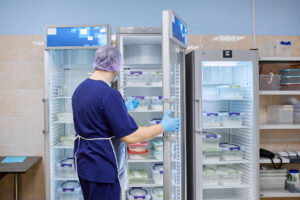Introduction
In the realm of healthcare, the proper storage of medicines and vaccines is a matter of life and death. The delicate nature of these pharmaceuticals demands precise environmental conditions to maintain efficacy and ensure patient safety. A deviation by even a few degrees can render a life-saving vaccine ineffective or a critical medicine unsafe. As the leading force in storage monitoring technology, Swift Sensors is revolutionizing this challenge with cutting-edge wireless sensor networks for hospitals.
Recent research, including reports by the World Health Organization (WHO), has underscored the critical impact of storage conditions on medical supplies. The WHO’s vaccine storage and distribution guidelines highlight the global significance of proper temperature control. In the face of such strict requirements and potential consequences, the adoption of wireless sensor technology is not just an improvement but a necessary evolution in healthcare management.
The Importance of Accurate Medicine and Vaccine Storage
Vaccines, blood transfusions, biologics, and various medications require specific conditions to retain their properties. These conditions, as outlined by the Centers for Disease Control and Prevention (CDC), range from cold storage at 2-8°C to frozen storage at -50 to -15°C. Any mishandling can lead to the degradation of chemical compounds, reduced potency of vaccines, and ultimately, the risk of delivering ineffective treatments.
Maintaining these conditions is not simply a matter of protocol but one of ethical responsibility. Inaccurate storage can lead to vaccine-preventable diseases, cause outbreaks, and erode public trust in healthcare institutions. As such, ensuring the integrity of medical storage is a cornerstone of public health policy and patient care standards.
Challenges in Traditional Storage Monitoring
For many years, hospitals relied on manual checks and analog data logging to monitor storage conditions. These methods, while foundational, are fraught with vulnerabilities. The FDA has documented incidents where vaccines stored at incorrect temperatures resulted in mass inoculation failures, often going unnoticed until adverse effects occur. These errors can stem from simple oversights, such as failing to close a storage unit properly, to more complex issues like equipment failure.
The traditional approach to storage monitoring is not only prone to human error but also lacks the granularity needed for modern compliance audits. Hospitals are expected to provide detailed logs, showing continuous compliance with storage guidelines. The manual approach is labor-intensive, error-prone, and inherently reactive rather than proactive.
The Role of Wireless Sensors in Hospital Storage Monitoring
Enter the age of wireless sensors — compact, reliable, and highly accurate devices capable of monitoring a range of environmental conditions. These sensors provide real-time data on temperature, humidity, and access, among others. A significant advantage over traditional methods is the automation of data collection and the ability to set thresholds for alerts.
Wireless sensors send data to a central monitoring system, which can trigger instant alerts to hospital staff if any parameter deviates from the set norm. This immediacy is crucial in preventing the loss of valuable medical supplies. Furthermore, technological advancements in sensor accuracy and network reliability have made these systems indispensable in modern healthcare operations.
Ensuring Continuous Monitoring and Compliance
With wireless sensors, hospitals can achieve an unprecedented level of control over their storage environments. These systems can be programmed to provide continuous monitoring, with data logged at regular intervals, ensuring a consistent and reliable record that meets regulatory requirements.
Integration with existing hospital information systems is seamless, often requiring minimal setup. This ensures that data isn’t just collected but is also readily available for compliance audits and quality control assessments. Health authorities, such as the Joint Commission, emphasize the need for continuous monitoring, and wireless sensor networks provide a solution that aligns perfectly with these guidelines.
Cost-Benefit Analysis of Wireless Sensor Systems
The upfront costs of wireless sensor networks are very economical especially when evaluated against the potential costs of non-compliance and medication waste. For example, a single incident of vaccine spoilage can cost a hospital tens of thousands of dollars, not to mention the potential harm to patients and the hospital’s reputation.
Studies in healthcare operations management have shown that investments in reliable storage monitoring systems can lead to substantial savings over time. By preventing spoilage, ensuring compliance, and reducing the time staff spend on manual monitoring, hospitals can achieve a positive return on investment within a relatively short period.
Installation and Maintenance of Wireless Sensor Networks
The installation process for wireless sensors is straightforward. It involves strategically placing sensors throughout storage areas and connecting them wirelessly to a central gateway device. Batteries typically last 6-8 years in the sensors.
Manufacturers provide detailed guidelines for installation and maintenance, ensuring hospitals can get the most out of their investment. Additionally, many offer support services to assist with any technical issues that arise, minimizing downtime and ensuring continuous protection of sensitive medical supplies.
Training Staff on Using Wireless Sensor Systems
Staff training is an integral part of implementing a new technology. Hospitals must ensure that staff understand how to interact with the sensor system, respond to alerts, and interpret the data collected. Effective training not only involves understanding the technology but also developing protocols for responding to potential storage issues.
Sensor manufacturers often provide training modules and instructional materials as part of their package. Best practices suggest that hospitals should also conduct regular training sessions and drills to ensure staff are comfortable with the systems and understand the importance of their role in maintaining storage integrity.
The Future of Wireless Sensors in Healthcare
The future of wireless sensors in healthcare is bright, with technological advancements rapidly emerging. The Internet of Things (IoT) promises even greater integration of sensors with hospital networks, providing a more interconnected and automated approach to monitoring. Artificial intelligence (AI) is also set to play a role, with predictive analytics capable of identifying potential issues before they arise.
As these technologies continue to evolve, the potential applications of wireless sensors in healthcare will expand, offering new ways to enhance patient care, improve operational efficiency, and ensure the safety of medical supplies.

